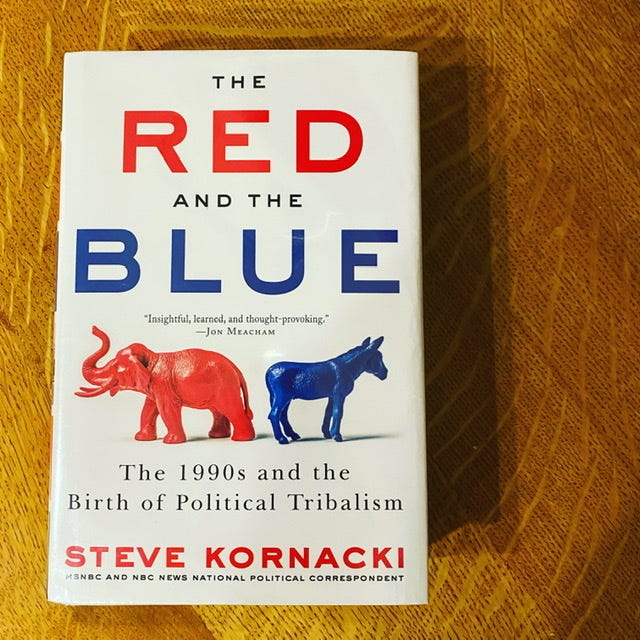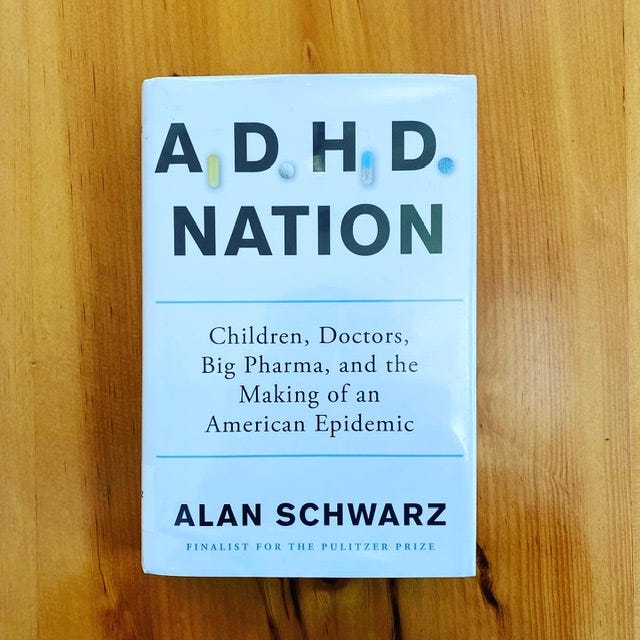What to Read Next (No. 148): politics and culture of the 90s—how we got to here
A couple weeks ago I started reading The Red and Blue by Steve Kornacki—little did I know that he would earn internet and cable news fame during our election week. His exploration of the origins of our modern partisanship was eye-opening, grippingly dramatic, and a bit infuriating. To understand 2016, 2020, future presidential elections, and the never-ending bitter gridlock in Congress, it’s essential reading.
I also finished a skewering journalistic take on the rise of ADHD diagnoses in America and the big pharma companies profiting from it. Though not directly related to the political moment, it does speak to both the culture wars and corporate greed of the last couple decades.
Let’s get to it.
The Red and the Blue: The 1990s and the Birth of Political Tribalism by Steve Kornacki
“Contrast wins elections, not compromise.”
Published: 2018 | Pages: 422
In the elections of this century, the results have hinged on a handful of swing states. Most of the other states are pretty solidly entrenched in their red or blue ways. Before that, though, each state was more or less a toss up—each four years it could move one way or another depending on the candidates, not necessarily just the political party. California wasn’t solidly blue until ‘92, Louisiana went back and forth every few election cycles, the entire Midwest used to be a toss-up; in 1984 the electoral map we’re all familiar with was almost solid red, in 1964 it was almost solid blue—results that are unthinkable today.
What happened in the ‘90s to get us to today’s bitterly partisan, hate-filled, firmly entrenched and somewhat predictable electoral map?
That’s the question Steve Kornacki brilliantly answers in The Red and the Blue. At the start, we get see-sawing chapters about up and coming politicians Bill Clinton and Newt Gingrich, neither of whom come across as likable. Then those two figures converge in a number of legislative fights which upend Washington, D.C. and transform politics in America for a generation or two . . . and perhaps longer.
Newt, “a lover of political combat,” led the GOP to drift further to the right, shockingly winning the House in 1994’s blue bloodbath (Republicans gained over 50 seats!); Democrats, meanwhile, tried to figure out how to respond and win voters back. The old guard politicians who favored bipartisanship and chumminess were ushered out in favor of a new generation of foot soldiers who valued battle more than governance.
Today, then, we end up with an extreme version of political gridlock.
As you surely know, I read a lot of history. While our nation isn’t the most hatefully divided it’s ever been, we’re not that far off. In my experience, though, the extremes on both the Left and Right are what you’re seeing in the media. Most people, no matter who they support, are doing their best and just trying to make it through 2020. It’s a scary, stressful year, chock-full of terrifying unknowns. Kornacki doesn’t offer any solutions to the bipartisanship (he’s just telling a story), and I don’t have ideas either, except to try to show even more compassion and to try to live out my belief that love and empathy are bigger and more powerful than politics.
Bottom line on the book itself: The Red and the Blue is a compelling read which shows just how we got into this quagmire. It ends somewhat abruptly after the 2000 election, so I’m hoping there’s a follow-up in the future.
A Few Quick Links
End of year lists are already starting to pop up. Here’s TIME’s best 100 of the year.
Reviews are starting to pop up for Barack Obama’s A Promised Land, volume one of his presidential memoirs. It’s guaranteed to be the bestselling book of the year. Here’s the NYT review; and here’s the preface to the book, featured at The Atlantic. Needless to say, I’m excited to get my hands on it.
LitHub recently published a very fun list of the 50 greatest apocalypse novels of all-time. Check it out.
Finally, I’ll toot my own horn one tiny bit: My piece on the self-care routines of the presidents was lost in the midst of Election Day, but I think it’s both a fun and worthwhile article about a subject that I’m obviously deeply interested in.
ADHD Nation: Children, Doctors, Big Pharma, and the Making of an American Epidemic by Alan Schwarz
Published: 2016 | Pages: 263
“the child comes to our attention because of his family’s or his community’s initiative. Who, then, are we to classify diagnostically: the child, the family, the community, or all three?” —Leon Eisenberg
Research has shown that right around 5% of children can be diagnosed with ADHD—these are kids whose hyperactivity and inability to focus is dangerous not only to the child, but to the family as well. In those instances, amphetamines can help calm things down and allow that child to live a pretty “normal” life.
The problem is that anywhere from 15-20% of kids (largely boys, but not exclusively) and a growing percentage of adults are being diagnosed ADHD and given those potentially harmful amphetamines. Additionally, there’s an exploding population of high school and college students getting their hands on Adderall as a performance enhancing drug. As a result, a handful of junk doctors and a ton of drug makers are lining their pockets with cash.
Journalist Alan Schwarz sought to figure all this out in his revelatory book. He starts with the history of the disorder and its early treatments; in the profiling of Dr. Keith Conners the reader gets a glimpse of both the promise and peril of ADHD diagnoses and drugs. Conners, in good faith, created the infamous diagnostic questionnaire that unfortunately led to some of today’s problems:
“However rooted in science, Conners’s symptom questionnaire measured not necessarily a child’s behavior, but outsiders’ impression of it—their tolerance for it. The evaluations remained dangerously subjective . . . depending on their own values, even whims.”
Beyond the doctors, Schwarz gets in the dirt with the parents and kids who’ve been affected by ADHD—particularly in the stories of two people: one is a young girl seemingly afflicted by the disorder and given some misguided treatment, the other is a high school student who easily faked his way into a diagnosis which turned into a very real drug problem. Schwarz details how those stories began and how they played out over the long-term.
It’s a moving book, inevitably compared to Dopesick, which asks hard questions not only about drug use, but more importantly about the role of family and community in the midst of a drug epidemic. As Eisenberg ponders in the quote at the top of this review, is the ADHD over-diagnosis problem solely a drug company problem, or does it also stem from a combination of tired, well-meaning parents (who may understandably think their kid is too hyper when really he’s just normal hyper) and overly busy doctors who aren’t educated enough or have time enough to make thoughtful diagnoses?
It’s a lot like the opioid problem: Schwarz finds answers that are honestly somewhat predictable (there’s plenty of blame to go around), but terribly hard to detangle from the reality of the current situation. When there are billions of dollars to be made, knowledge of the problem won’t do a whole lot. Ultimately, change has to come from greater regulation of the companies that are exploiting the health and well-being of millions of families, as well as from some of the doctors on the ground who are handing out Adderall like its Halloween candy.
ADHD Nation is a fast-moving, eye-opening book about a problem that every parent should be well-educated about.
That’s all for me this week. Thanks for reading this slightly more impassioned newsletter than what I’m used to sending; I deeply appreciate your time, attention, and inbox space.
-Jeremy


